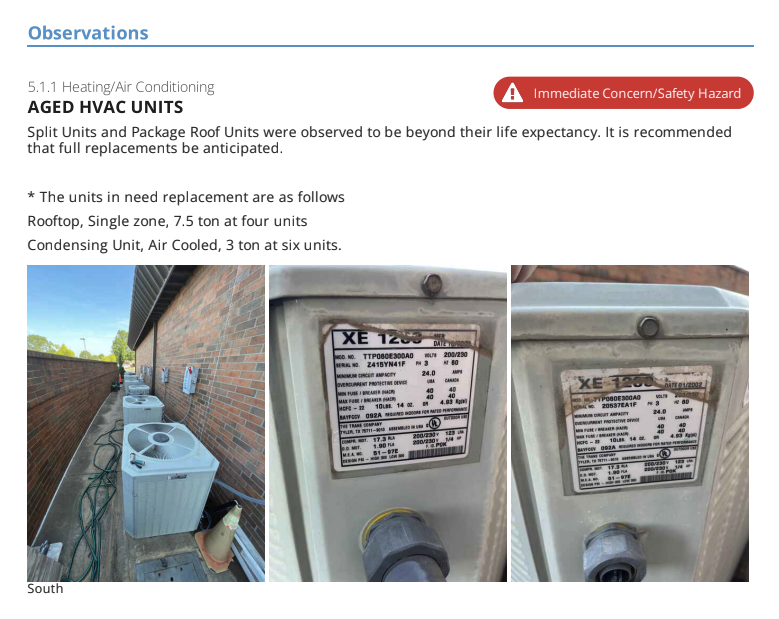Capital planning and financial forecasting help commercial real estate (CRE) stakeholders prepare for both immediate and long-term expenses, including buyers, owners, investors, tenants, and those involved in operations planning. The process starts with understanding a property’s current physical condition. This guide outlines key areas of the process, including:
The Three-Step Process: Planning, Budgeting, and Forecasting
Capital planning is the financial process of identifying major repairs, replacements, or improvement projects and outlining what needs to be done, when, and how much it will cost. It helps stakeholders allocate funds to the right projects and prepare for large expenses, such as roof replacements, HVAC upgrades, or parking lot resurfacing, based on the building’s current condition.
Financial forecasting refers to projecting future expenses over a defined period, often 5, 10, 15, or 30 years, and supports capital planning for a property’s or portfolio’s future financial performance. It helps anticipate future costs and funding needs.
Regular inspections help extend the life of assets and minimize financial, safety, and operational risks. When paired with cost-estimating services, they help map out the planning, budgeting, and forecasting three-step process for success in commercial real estate.

Commercial Property Inspection Services for Capital Planning and Financial Forecasting
Commercial property inspections are a key part of due diligence, capital budgeting, and risk reduction. By assessing and documenting property conditions and deficiencies, inspectors provide the foundation for both immediate expenses and long-term forecasting.
Because inspectors work closely with stakeholders throughout a property’s lifecycle, including acquisitions, portfolio management, and lease transitions, they serve as a consistent source of insight and documentation as conditions evolve and new planning needs arise.
Tenants may also be involved as stakeholders, particularly when they share responsibility for maintenance or capital improvements. Finding a certified commercial property inspector can help align budgeting efforts and inspection services with the property’s actual priorities and needs.
Cost-to-Cure Report
A cost-to-cure report is a table that compiles construction cost estimates (CCEs) to help determine how much funding to set aside for immediate expenses. These CCEs are estimated costs for repairs, improvements, and enhancements to the property, and are typically referenced by section or finding in the inspection report. The table is built from the physical conditions observed and documented during the inspector’s walk-through survey.
Capital Reserve Forecast Report
A capital reserve forecast helps determine the necessary funds to set aside to cover both immediate and capital expenses (CapEx). Capital expenses refer to major, long-term costs. Like a cost-to-cure report, this forecast is based on property conditions observed during the inspection and the remaining useful life of building systems.
The capital reserve table spans yearly intervals, typically 5, 10, or 15 years, and includes a compounding inflation factor. It supports those involved in CRE transactions or operations in planning ahead. While it does not assess the property’s current reserve funding or financial strategy, it can serve as a useful reference for advisors and specialists involved in long-term capital planning.
Capital Reserve Study
A capital reserve study is a comprehensive report that combines an inspection with an analysis of current reserve funds. A reserve fund refers to money set aside to cover future expenses for a property, often for major repairs, upgrades, or unexpected costs.
The study outlines a prioritized 30-year plan for capital projects and reserve funding. HOAs and other community associations typically require reserve studies to support long-term financial planning and meet fiduciary responsibilities.
Because commercial property inspectors perform periodic maintenance and condition assessments for HOAs and multi-family properties, they may offer this service themselves, partner with reserve advisors and specialists, or be able to refer clients to one.
Cost Segregation Study
A cost segregation study is a tax strategy that identifies and classifies individual components within a commercial property for accelerated depreciation. By separating eligible assets from the main building structure, property owners and investors can shorten depreciation timelines and increase near-term tax deductions.
Cost segregation studies are based on an IRS-sanctioned program tied to the Investment Tax Credit and cost allocation, and are typically performed by qualified engineering or tax firms. Some inspectors have backgrounds in engineering, appraising, and cost estimating and may offer these studies themselves, or they may be able to refer clients to a provider.
Which Report or Study Aligns with the Property’s Financial Planning Goals?
Q1: Is the goal to understand current property conditions and determine immediate costs for a potential purchase, financing decision, or capital planning?
A cost-to-cure report aligns with this goal.
This report compiles estimated repair and replacement costs based on current property conditions. It helps buyers, tenants, and other property decision-makers determine how much to set aside for immediate expenses related to deficiencies documented in the inspection report.
Q2: Is the goal to plan for capital expenses over the next 5-15 years based on the building’s condition and expected system lifecycle?
A capital reserve forecast aligns with this goal.
This forecast is also based on the building’s current condition and the remaining useful life of its systems, but it’s especially useful for long-term planning. It helps those involved in CRE transactions or operations prepare for major improvements over 5-, 10-, or 15-year intervals.
Q3: Is the property part of an HOA, condo association, or multi-family community that requires a formal 30-year funding plan?
A capital reserve study aligns with this goal.
This study includes both a property inspection and an analysis of the current reserve fund. It provides a prioritized schedule and long-term funding plan to support financial health and meet fiduciary responsibilities.
Q4: Is the goal to accelerate tax depreciation for a recently acquired or renovated property?
A cost segregation study aligns with this goal.
This tax strategy breaks down building components to separate short-life assets for faster depreciation. It’s typically used by investors and building owners looking to reduce near-term tax liability.
Integrating Inspections with Cost Estimating and Forecasting
Commercial property inspectors who hold the CCPIA® Certified Commercial Property Inspector designation are trained to assess and document property conditions. Many also complete specialized training in construction cost estimating and financial forecasting, allowing them to provide immediate cost tables and long-term forecasting tools based on current building conditions to support capital planning.
With a deep understanding of building systems and stakeholder priorities across all stages of a property’s lifecycle, as well as the broader journey of building owners, tenants, and investors, inspectors are naturally positioned to meet the evolving needs of the commercial real estate industry.
Clear communication about acquisition plans, maintenance priorities, and asset performance allows inspectors to align their services with both the property’s and the client’s goals. Cost tables and related tools support budgeting and strategic planning, from immediate financial insight to long-term forecasting.
Additional Resources for Commercial Property Inspectors:


